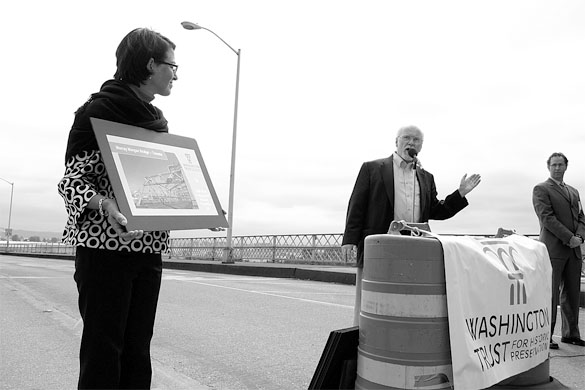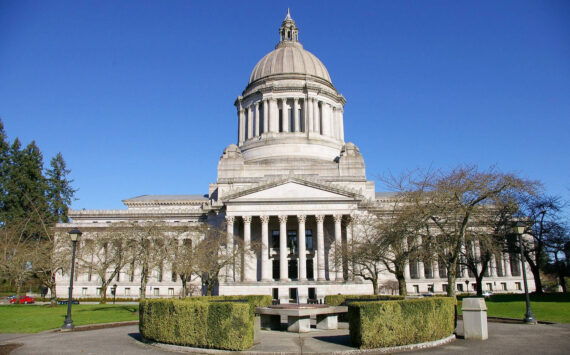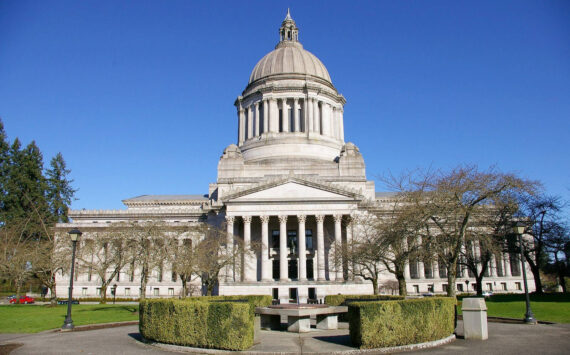For the small staff of the Washington Trust for Historic Preservation, it’s easy to remember the organization’s mission: protecting Washington State’s historic places through advocacy, education, collaboration, and stewardship.
One reason: the Trust’s offices are tucked away on the second floor of the 108-year-old, English Tudor style Stimson-Green Mansion in Seattle’s First Hill neighborhood. On a recent Wednesday afternoon, Cathy Wickwire, a program associate who also manages the mansion, pulled open the heavy timber front door, like cracking open the seal to a large box of Seattle history, and welcomed a reporter inside for a meeting with the Trust’s Executive Director Jennifer Meisner and Field Director Chris Moore.
The 10,000-square-foot house is the former residence of lumberman and developer Charles D. Stimson and his family, who lived there between 1901 and 1915. According to the mansion’s Web site, the home was later traded for land near Fifth Avenue and Pike Street before it was sold to banker Joshua Green and his family, who lived there for more than six decades. When Green died, the home was listed on both the state and national historic registers and designated a City of Seattle landmark. In 1986, the home was purchased by Priscilla Bullitt Collins, the Stimson’s granddaughter. Five years later, she donated the mansion to the Trust.
Another reason: the Trust has been around since 1976.
Although it is based in Seattle, it is known among preservationists throughout the state. The Index first became aware of the Trust two years ago, when Meisner and Moore attended a press conference held by the Washington State Department of Archaeology and Historic Preservation (DAHP) in the downtown Tacoma Passages Building; the event marked the release of DAHP’s study detailing the economic benefits of historic preservation in the state.
Since then, the Trust has been a regular presence in Tacoma and Pierce County. Last month, Moore appeared before Pierce County Council to voice his concerns over a budget amendment that would reduce funds for historic preservation programming. Last year, Meisner and Moore chose Tacoma to hold the Trust’s annual press conference to announce its list of the state’s most endangered historic properties. The pair, along with State Rep. Dennis Flannigan (D-Tacoma), presented the list on the Murray Morgan Bridge deck.
Also, four Tacomans serve on Washington Trust’s Board of Directors, along with the historic preservation officers in Steilacoom, Lakewood, Gig Harbor, Tacoma, and Puyallup.
“The Trust has been consistently supportive of our work, highly professional in all of our dealings with them, and as effective as they can possibly be given slim staffing and funding,” says Historic Tacoma Board President Sharon Winters. “I marvel at what they accomplish and how responsive they are to our queries.”
Winters believes the Trust succeeds because it understands its constituents and works to make the necessary political connections. “Their strengths are in their professionalism and in their subject expertise in the public policy arena,” she adds.
For the past 10 years, the Trust has awarded $43,500 to 57 projects through its Valerie Sivinski Washington Preserves grant program: in 2007, Historic Tacoma received $1,000 toward restoration of the Pythian Temple, and Tacoma Railcar Preservation Society received $1,000 toward the restoration of a 1910 Northern Pacific dining car. The program has grown from $1,250 awarded in 1998 to a record $7,500 awarded in 2007.
“Each year I’ve been here, we’ve gotten more applicants and better projects,” says Moore. “Even though our maximum grant award is $2,000 per project, it really helps preservation happen at the local level.”
During the current Legislative session, Meisner and Moore have closely followed several issues: the Trust opposed a proposal to fold DAHP into Washington State Parks, where it would have been buried; it is still working the halls of the capitol to preserve funding for the Washington State Main Street Program, which the Trust argues creates jobs while preserving historic downtowns; and it is pressing hard for continued funding for the preservation of heritage barns and historic county courthouses. The Trust has administered both programs for DAHP.
Indeed, the morning of our interview, Moore had just returned from a 7:00 a.m. meeting of the Heritage Caucus in Olympia — a statewide group of preservationists who meet once a week during legislative sessions to discuss legislative concerns and strategies related to historic preservation.
“I get to travel a lot and go see all the historic sites of Washington state,” says Moore. “It is really a dream job. It’s remarkable.”
On the organization’s work in Olympia, Meisner says, “I’m really proud of how far we’ve come in our advocacy efforts in Olympia. I think we continue to build on the relationships we’ve made. It’s not just the staff, but it’s our board members and past board members. Representing the Washington Trust and the broader statewide preservation constituency, we can get meetings with legislators. We really are a known entity. That’s what it’s really about. Being able to talk to legislators and hopefully sway them in support of what we think are important.”
The Tacoma Daily Index met Meisner and Moore last week to discuss their work in Olympia this year and how historic preservation advocacy is faring in a tough economy.
TACOMA DAILY INDEX: How active has the Washington Trust been during this legislative session? What issues have been on your radar?
JENNIFER MEISNER: We have been extremely active this session. Even before the sessions started, we had meetings. We set out our legislative agenda very early in the year. There were three issues topping our agenda this year. The first was a proposal to consolidate DAHP into Washington State Parks. The Washington Trust fought really hard in 2005 to get DAHP moved out of the Community, Trade and Economic Development Department (CTED). It had been buried in that huge department for many years. Really, when it’s a small program in a huge department, there’s a big administrative cost and they really just don’t get the recognition. They’re just not as visible. They were pulled out in 2005 to become the stand-alone agency and a cabinet level agency.
With this proposal, the governor’s budget moves DAHP into state parks. We really felt that it would be a huge step backwards for preservation because, yet again, they would be kind of swallowed up by a big department. Aside from that, DAHP is a regulatory body and they regulate state parks. It would have been a very tricky marriage between these two departments. We did a lot research and figured out it would have cost the state a considerable amount of money in just re-writing the rules and going through the public process to change their whole relationship with parks. That was one of our main issues and we’re really excited because it looks like now DAHP is going to stay a stand alone entity. The Heritage Caucus played a really big role in keeping DAHP on its own because every legislator and every constituent that attended that meeting understood that it really would not have been a positive move for preservation.
INDEX: What is another legislative issue you’re working on?
MEISNER: We are working really hard to keep the same funding levels for the Washington Main Street Program. It’s a really small program, but it’s a great economic development program that’s also in CTED. They have a staff of two-and-a-half people and the governor’s proposal would have significantly cut their budget. With the cuts, they would have gone down to a staff of one. Unfortunately, that hasn’t had as good of an outcome. When the House budget came out, it supported the governor’s budget. And then the Senate budget even cut more money. We’re hoping there will maybe be another solution to keep that program alive.
CHRIS MOORE: The Main Street Program actually comes from the National Trust for Historic Preservation, but it’s implemented state-wide and across states. Here in Washington, there are 85 organizations that participate in the Main Street Program at some level. If you are a ‘Main Street Community,’ it’s a really important economic generator and real important for downtown revitalization. This is our Port Townsend, Port Angeles, Ellensburg, Walla Walla. These are all Main Street communities. Gig Harbor is a new one, as is Olympia, Chelan, Kennewick. These are downtown business associations that get buy-in from local businesses, local merchants, and work on all kinds of projects. Just this last year, three new Main Street communities were added. In 2005, they were able to get some additional staff. Now the budget would take them back to pre-2005 levels. There won’t be any more growth in that program. There’s all kinds of great studies out there showing that $1 million spent on a rehabilitation project is going to create more jobs and have a bigger multiplier on the local economy than $1 million for new construction. The reason being that rehabilitation is labor-intensive as opposed to material-intensive. You are working on existing buildings. You need the people to do it. You’re not ordering newly manufactured products from somewhere. And then you’re using more labor — and often times local labor — that money gets multiplied within the local economy. So those people earn their salaries end up going out and spending locally. That was the big argument we were making this year in regard to both the courthouse and the barn program. Even though there was only $500,000 for barns, they got us matching grants. So a barn owner gets $20,000, they’re doing a $40,000 project, they’ve got to go buy their lumber, nails, whatever they need locally.
MEISNER: We’re really hopeful. We were in the governor’s budget for $5 million again for the courthouse program, and a half-million for barns. In the House budget, we were in for $3 million for courthouses, barns didn’t have any funding. We’re trying to see if there’s any way to get even a couple-hundred thousand — hopefully more than that — just to keep the project going.
INDEX: With the economy the way it is right now — cities, counties, and the state facing deficits — do you feel that preservation is being targeted as a place to cut? Is your job more difficult in terms of selling the importance of preservation at a time when governments are trying to save money and close budget gaps?
MOORE: On one level, the economic situation relieves pressure for preservation strictly from a building standpoint. What I mean by building is new construction. There is not the pressure to knock down an old building and build a new high-rise condo because that market has simply evaporated right now. So it relieves the pressure on the actual buildings, on one hand, on threatening them. On the other hand, it also increases pressure on the long-term maintenance of them because if people don’t have money just for operations, you know the money they did have to do that important preservation project is just going to get pushed back again. So you get deferred maintenance over time of these buildings.
MEISNER: For me, too, I think what it means is that now more than ever we need to be very articulate in conveying the message that historic preservation is not just nostalgia. It’s really an economic development tool. It generates jobs. I think that’s the message. Many of us value preservation for what it is, and of course it’s critical to save our valuable and irreplaceable built heritage. Once it’s gone, it’s gone. We all know that. But I think now more than ever we have to really be making the case strongly to our elected officials and others that it can really help in these difficult times.
INDEX: Have you been able to communicate that? You mentioned the Main Street Program is a target. Pierce County’s historic preservation funding was a target this year. In my own experience covering this issue, it’s my impression a lot of people feel preservation is a nice thing to have. But during tough economic times, maybe it’s not necessary.
MOORE: I think that’s a fair assessment. [Some people say] it’s a great amenity or luxury when times are good. ‘Isn’t that fine? Isn’t that neat what they are doing? But really, when we get down to it, this is a luxury.’ I think that’s a fair assessment. There’s continual education that has to happen. I think it’s a cultural thing to some degree, as well. Thinking that newer is better. Progress always means wiping a landscape clean and creating something new. There’s almost a cultural thing going on. It’s almost equated with progress. Preservation is not progress — it’s stepping back.
MEISNER: It’s really our job to dispel those myths. If your building becomes a landmark, your property values are going to go down. There are studies out there that show that’s not necessarily the case. We really have to work hard to bring the general public along with us in our belief that it really is important and valuable. But you’re right. It’s tough for any movement or non-profit right now working in any field. It’s a challenging time for everybody.
MOORE: But you’re right. It is a tough sell sometimes. On the one hand, you can get a property owner’s sentiment that preservation is going to restrict property rights. People really want to stay away from that as much as possible. It’s the Wild West still in 2009. There’s a real concern about that. I think we are starting to see now policies in place around green practices. In Seattle, if you can show, basically, if you are a contractor and developer you can streamline the permitting process if you show that you are going to do a green deconstruction of a building site as opposed to carting things away to a landfill. In other words, if you can show your diversion rate — meaning the amount of material you’re going to divert from the landfill — is a certain threshold, then there’s a streamlined process you can go through to get your permit. For a developer, that means less time to get my permit, I’m saving money. How do we, as preservationists, tap into that thinking and extend it to not just deconstruction but house rehabilitation or other policies which will encourage the re-use of existing buildings in ways we haven’t thought up yet? Maybe those include relocating houses, exceptions to different zoning regulations. With the focus that’s on green practices, we still need to do a job of tapping into that and again saying, ‘Look, preservation is doing that already.’
I think it’s real important to make the case — you see it nationally and I think other organizations like ours that are statewide organizations in other areas of the country are making this case now more than ever — in addition to the economic development piece, preservation is sustainable. It’s a green practice from the standpoint of if you are preserving a building, you’re not sending things to the landfill. There are certainly some places in terms of energy efficiency that historic buildings need to improve on. But you don’t do that by knocking a building down and building a brand-new LEED-certified energy efficient building. While that’s great, there’s still a huge amount of energy that’s lost by taking down that historic building.


Todd Matthews is editor of the Tacoma Daily Index and recipient of an award for Outstanding Achievement in Media from the Washington State Department of Archaeology and Historic Preservation for his work covering historic preservation in Tacoma and Pierce County. He has earned four awards from the Society of Professional Journalists, including third-place honors for his feature article about the University of Washington’s Innocence Project; first-place honors for his feature article about Seattle’s bike messengers; third-place honors for his feature interview with Prison Legal News founder Paul Wright; and second-place honors for his feature article about whistle-blowers in Washington State. His work has also appeared in All About Jazz, City Arts Tacoma, Earshot Jazz, Homeland Security Today, Jazz Steps, Journal of the San Juans, Lynnwood-Mountlake Terrace Enterprise, Prison Legal News, Rain Taxi, Real Change, Seattle Business Monthly, Seattle magazine, Tablet, Washington CEO, Washington Law & Politics, and Washington Free Press. He is a graduate of the University of Washington and holds a bachelor’s degree in communications. His journalism is collected online at wahmee.com.








